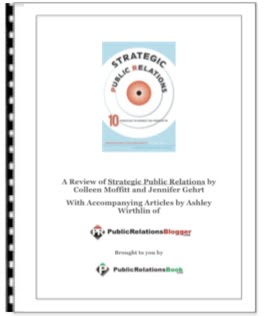________________________________________________________________________
 I say to business, non-profit and association managers, a key part of your job description is - or should be - do everything you can to help your organization’s public relations effort as it strives to persuade important outside stakeholders to your way of thinking. Especially when it’s YOUR PR program that is tasked to move those stakeholders to behaviors that lead to the success of YOUR department or division.
I say to business, non-profit and association managers, a key part of your job description is - or should be - do everything you can to help your organization’s public relations effort as it strives to persuade important outside stakeholders to your way of thinking. Especially when it’s YOUR PR program that is tasked to move those stakeholders to behaviors that lead to the success of YOUR department or division.
Which is why I suggest that business, non-profit and association managers embrace what I call PR’s 8 fix factors, those steps necessary to prepare their public relations operation for the battles certain to lie ahead.
The fix factors are based on this fundamental premise: People act on their own perception of the facts before them, which leads to predictable behaviors about which something can be done. When we create, change or reinforce that opinion by reaching, persuading and moving-to-desired-action the very people whose behaviors affect the organization the most, the public relations mission is accomplished.
Fix Factor 1
For starters, I caution Mr/Ms Manager that you may find yourself data-challenged should you be unaware of just HOW most members of that key outside audience perceive your organization.
Has anyone sat down and listed those external audiences whose behaviors could hurt your unit badly? Then prioritized them according to the impacts they have on your operation? A necessary first step in creating the right public relations objective because, while behavior is the goal, and a host of communications tactics are the tools, our strategy is the leverage provided by key audience perception. Sometimes called public opinion.
Fix Factor 2
Lets take a look at the audience you place at the top of your prioritized target audience list. Because there could be negative perceptions out there, someone must interact with members of that audience and ask a number of questions. Do you know anything about our organization? Have you had any kind of contact with our people? Have you heard anything good or bad about us or our services and products? Watch respondents closely for hesitant or evasive answers. And stay alert for inaccuracies, rumors, untruths or misconceptions.
Fix Factor 3
Here, fortunately, you have a choice. You and your PR staff can interact with members of that target audience yourselves, which seems appropriate since your PR folks are already in the perception and behavior business. Or, if budget is available, you can hire professional survey counsel to do the work for you.
What are you hearing during your perception monitoring sessions? Misconceptions that need straightening out? Rumors that should not be allowed to fester? Inaccurate beliefs about your products or services that could drive people away from you? Do you notice other perceptions about your organization that need to be altered?
Fix Factor 4
The responses gathered by this kind of perception monitoring among members of the target audience provides just what you need to establish your public relations goal - the specific perception to be altered.
You might start with a straightforward goal like clearing up that misconception, correcting that inaccuracy or replacing a perceived untruth with the truth.
Fix Factor 5
Now, the right strategy sends the public relations program off to a good start because it shows you how to proceed towards your goal. Luckily, there are just three strategic choices for dealing with matters of opinion and perception. You can create perception/opinion where there may not be any, you can change existing opinion, or you can reinforce it. An effort should be made to match the strategy to the public relations goal you selected. Obviously, if you want to correct a misconception, you would use the strategy that changes existing opinion, not one that reinforces it.
Fix Factor 6
Here, there is a little more work to do in the form of the message that, hopefully, will alter people’s inaccurate perceptions of you and the organization.
Some serious writing is needed here. The corrective message to be communicated to members of the target audience is an opportunity to write something designed to change individual opinion, and that’s a positive experience for any writer.
Clarity is first, followed closely by accuracy and believability. Stick closely to the issue at hand - like that inaccurate belief, misconception or dangerous rumor. A compelling tone is useful because the message must alter what a lot of people believe, and that is a big job. Tryout the message on some colleagues for effectiveness.
Keep in mind that your message must be believable and that rather than delivering it in a high-profile news announcement, you may want to make the message part of another general interest release, presentation or address.
Fix Factor 7
Now you must throw that message to receivers in the end-zone or, continuing this scintillating mixture of metaphors, every bullet needs a gun to fire it at the target. Which brings us to the stable housing our beasts of burden - the communications tactics whose job it is to carry your message to the attention of those key target audience members.
Fortunately, there are many, many such tactics ranging from luncheons, news releases and personal contacts to print and broadcast interviews, speeches, press releases and dozens of others. Only requirement is that they have a proven track record for reaching your target audience.
Fix Factor 8
Soon, associates (and others) will inquire whether any progress is being made in altering the offending perception or opinion. If you’ve ruled out pricey survey counsel, your best hope of assessing that progress is a return to the field for a second perception monitoring session.
Yes, you and your PR team will ask the same questions as you did in the initial monitoring session. But this time, you’ll be looking for evidence in the responses that the offending perception is finally being altered. You need to see and hear signs that perceptions are actually moving in your direction.
That tells you that positive behaviors by your key external stakeholders cannot be far behind.
Please feel free to publish this article and resource box in your ezine, newsletter, offline publication or website. Robert A. Kelly © 2004.
About The Author
Bob Kelly counsels, writes and speaks to business, non-profit and association managers about using the fundamental premise of public relations to achieve their operating objectives. He has been DPR, Pepsi-Cola Co.; AGM-PR, Texaco Inc.; VP-PR, Olin Corp.; VP-PR, Newport News Shipbuilding & Drydock Co.; director of communications, U.S. Department of the Interior, and deputy assistant press secretary, The White House. He holds a bachelor of science degree from Columbia University, major in public relations. mailto:[email protected]. Visit his website.
Article Source.
Tags: public relation fixes, public relations
8 "Fix Factors" to Use in Public Relations
________________________________________
 I say to business, non-profit and association managers, a key part of your job description is - or should be - do everything you can to help your organization’s public relations effort as it strives to persuade important outside stakeholders to your way of thinking. Especially when it’s YOUR PR program that is tasked to move those stakeholders to behaviors that lead to the success of YOUR department or division.
I say to business, non-profit and association managers, a key part of your job description is - or should be - do everything you can to help your organization’s public relations effort as it strives to persuade important outside stakeholders to your way of thinking. Especially when it’s YOUR PR program that is tasked to move those stakeholders to behaviors that lead to the success of YOUR department or division.Which is why I suggest that business, non-profit and association managers embrace what I call PR’s 8 fix factors, those steps necessary to prepare their public relations operation for the battles certain to lie ahead.
The fix factors are based on this fundamental premise: People act on their own perception of the facts before them, which leads to predictable behaviors about which something can be done. When we create, change or reinforce that opinion by reaching, persuading and moving-to-desired-action the very people whose behaviors affect the organization the most, the public relations mission is accomplished.
Fix Factor 1
For starters, I caution Mr/Ms Manager that you may find yourself data-challenged should you be unaware of just HOW most members of that key outside audience perceive your organization.
Has anyone sat down and listed those external audiences whose behaviors could hurt your unit badly? Then prioritized them according to the impacts they have on your operation? A necessary first step in creating the right public relations objective because, while behavior is the goal, and a host of communications tactics are the tools, our strategy is the leverage provided by key audience perception. Sometimes called public opinion.
Fix Factor 2
Lets take a look at the audience you place at the top of your prioritized target audience list. Because there could be negative perceptions out there, someone must interact with members of that audience and ask a number of questions. Do you know anything about our organization? Have you had any kind of contact with our people? Have you heard anything good or bad about us or our services and products? Watch respondents closely for hesitant or evasive answers. And stay alert for inaccuracies, rumors, untruths or misconceptions.
Fix Factor 3
Here, fortunately, you have a choice. You and your PR staff can interact with members of that target audience yourselves, which seems appropriate since your PR folks are already in the perception and behavior business. Or, if budget is available, you can hire professional survey counsel to do the work for you.
What are you hearing during your perception monitoring sessions? Misconceptions that need straightening out? Rumors that should not be allowed to fester? Inaccurate beliefs about your products or services that could drive people away from you? Do you notice other perceptions about your organization that need to be altered?
Fix Factor 4
The responses gathered by this kind of perception monitoring among members of the target audience provides just what you need to establish your public relations goal - the specific perception to be altered.
You might start with a straightforward goal like clearing up that misconception, correcting that inaccuracy or replacing a perceived untruth with the truth.
Fix Factor 5
Now, the right strategy sends the public relations program off to a good start because it shows you how to proceed towards your goal. Luckily, there are just three strategic choices for dealing with matters of opinion and perception. You can create perception/opinion where there may not be any, you can change existing opinion, or you can reinforce it. An effort should be made to match the strategy to the public relations goal you selected. Obviously, if you want to correct a misconception, you would use the strategy that changes existing opinion, not one that reinforces it.
Fix Factor 6
Here, there is a little more work to do in the form of the message that, hopefully, will alter people’s inaccurate perceptions of you and the organization.
Some serious writing is needed here. The corrective message to be communicated to members of the target audience is an opportunity to write something designed to change individual opinion, and that’s a positive experience for any writer.
Clarity is first, followed closely by accuracy and believability. Stick closely to the issue at hand - like that inaccurate belief, misconception or dangerous rumor. A compelling tone is useful because the message must alter what a lot of people believe, and that is a big job. Tryout the message on some colleagues for effectiveness.
Keep in mind that your message must be believable and that rather than delivering it in a high-profile news announcement, you may want to make the message part of another general interest release, presentation or address.
Fix Factor 7
Now you must throw that message to receivers in the end-zone or, continuing this scintillating mixture of metaphors, every bullet needs a gun to fire it at the target. Which brings us to the stable housing our beasts of burden - the communications tactics whose job it is to carry your message to the attention of those key target audience members.
Fortunately, there are many, many such tactics ranging from luncheons, news releases and personal contacts to print and broadcast interviews, speeches, press releases and dozens of others. Only requirement is that they have a proven track record for reaching your target audience.
Fix Factor 8
Soon, associates (and others) will inquire whether any progress is being made in altering the offending perception or opinion. If you’ve ruled out pricey survey counsel, your best hope of assessing that progress is a return to the field for a second perception monitoring session.
Yes, you and your PR team will ask the same questions as you did in the initial monitoring session. But this time, you’ll be looking for evidence in the responses that the offending perception is finally being altered. You need to see and hear signs that perceptions are actually moving in your direction.
That tells you that positive behaviors by your key external stakeholders cannot be far behind.
Please feel free to publish this article and resource box in your ezine, newsletter, offline publication or website. Robert A. Kelly © 2004.
About The Author
Bob Kelly counsels, writes and speaks to business, non-profit and association managers about using the fundamental premise of public relations to achieve their operating objectives. He has been DPR, Pepsi-Cola Co.; AGM-PR, Texaco Inc.; VP-PR, Olin Corp.; VP-PR, Newport News Shipbuilding & Drydock Co.; director of communications, U.S. Department of the Interior, and deputy assistant press secretary, The White House. He holds a bachelor of science degree from Columbia University, major in public relations. mailto:[email protected]. Visit his website.
Article Source.
Tags: public relation fixes, public relations
Popular choices
- Non Gamstop Casino
- Mejores Salas De Póker
- Non Gamstop Casinos
- Siti Casino Online Non Aams
- Migliori Siti Casino Online
- UK Online Casinos Not On Gamstop
- Non Gamstop Casino Sites UK
- Non Gamstop Casino Sites UK
- UK Casino Not On Gamstop
- Casinos Not On Gamstop
- Online Casino
- オンラインカジノ
- UK Casino Not On Gamstop
- UK Casino Not On Gamstop
- Reputable Non Gamstop Casinos
- Casinos Not On Gamstop
- Best Non Gamstop Casinos
- Non Gamstop Casino
- Casinos Not On Gamstop
- Slots Not On Gamstop
- Non Gamstop Casino
- Casino Non Aams
- Casinos Not On Gamstop
Subscribe to:
Post Comments (Atom)






Comments (0)
Post a Comment